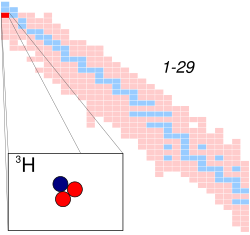Tritis
| Tritis | |
|---|---|
 Tritis | |
| Bendra | |
| Pavadinimas, simbolis | vandenilis-3, T, 3T,3H |
| Neutronai | 2 |
| Protonai | 1 |
| Nuklido duomenys | |
| Gamtinis paplitimas | 10−18 vandenilyje[1] |
| Pusėjimo trukmė | 12,32 metų |
| Skilimo produktai | 3He |
| Izotopo masė | 3.01604928 u |
| Sukinys | 1/2 |
| Perteklinė energija | 14949,794±0,001 keV |
| Ryšio energija | 8481,7963±0,0009 keV |
| Skilimo tipas | Skilimo energija |
| Beta skilimas | 0.018590 MeV |
Tritis (³H) – sunkusis radioaktyvus vandenilio izotopas, kurio branduolį sudaro vienas protonas ir du neutronai. Tričio atominė masė lygi 3. Pavadinimas kilo iš graikų kalbos: tritos – trečiasis (izotopas). Pusėjimo trukmė – 12,32 metai. Rečiausias tarp trijų vandenilio izotopų. Tritis susidaro kosminei spinduliuotei veikiant azoto atomus, gaunamas branduoliniuose reaktoriuose neutronais apšaudant ličio izotopą.[2]
Saulėje (ir kitose žvaigždėse) vyksta šio nepatvaraus vandenilio izotopo virtimo helio izotopu branduolinės reakcijos. Reakcijai vykstant, išsiskiria daug energijos, šildančios Žemę ir kitas Saulės sistemos planetas. Vandenilinių bombų veikimas didžiąja dalimi pagrįstas tričio savybe atpalaiduoti milžiniškus energijos kiekius.
Tritis gali jungtis su deguonimi ir sudaryti sunkųjį vandenį. Taip pat reaguoja su Li, Ti, Zr – susidarant tritidams.
Tritis atrastas 1934 m. Ernesto Rezerfordo, Marko Olifanto ir Polo Harteko eksperimento, per kurį deuteris, kitas vandenilio izotopas, buvo bombarduojamas deuteronais, metu.[3][4] Tačiau eksperimento metu tritis negalėjo būti išskirtas. Jį pirmąkart 1939 m. susintetino Luisas Alvaresas ir Robertas Kornogas, taip pat pastebėję radioaktyvias tričio savybes.[5][6]
Šaltiniai
[redaguoti | redaguoti vikitekstą]- ↑ Tritium. Encyclopædia Britannica.
- ↑ tritis. Visuotinė lietuvių enciklopedija (tikrinta 2024-03-15).
- ↑ Oliphant, M.L.; Harteck, P.; Rutherford, L. (1934). „Transmutation effects observed with heavy hydrogen“. Nature. 133 (3359): 413. Bibcode:1934Natur.133..413O. doi:10.1038/133413a0. S2CID 4078529.
- ↑ Oliphant, M.L.E.; Harteck, P.; Rutherford, L. (1934). „Transmutation Effects Observed with Heavy Hydrogen“. Proceedings of the Royal Society A: Mathematical, Physical and Engineering Sciences. 144 (853): 692. Bibcode:1934RSPSA.144..692O. doi:10.1098/rspa.1934.0077.
- ↑ Alvarez, Luis; Cornog, Robert (1939). „Helium and Hydrogen of Mass 3“. Physical Review. 56 (6): 613. Bibcode:1939PhRv...56..613A. doi:10.1103/PhysRev.56.613.
- ↑ Alvarez, Luis W.; Trower, W. Peter (1987). Discovering Alvarez: Selected works of Luis W. Alvarez, with commentary by his students and colleagues. University of Chicago Press. pp. 26–30. ISBN 978-0-226-81304-2.
Text is available under the CC BY-SA 4.0 license; additional terms may apply.
Images, videos and audio are available under their respective licenses.
